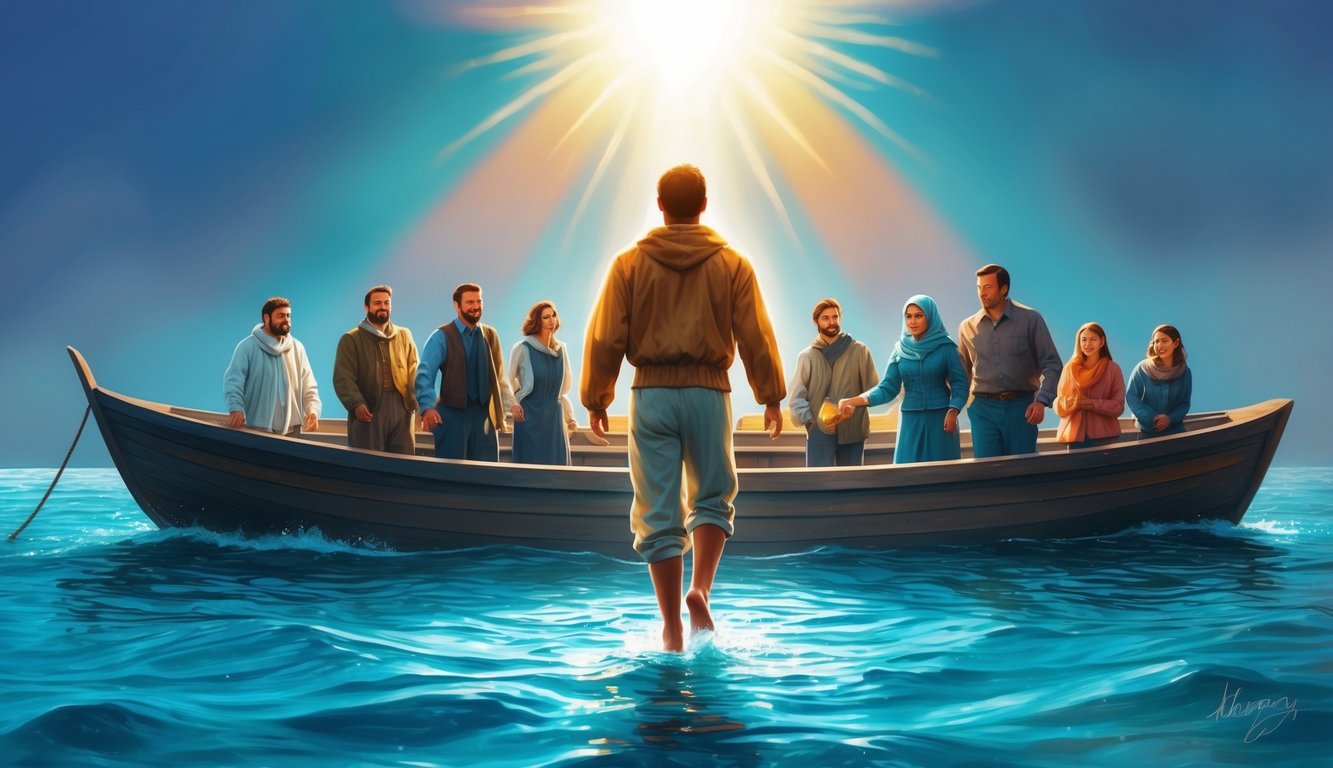Don’t Miss Out On This Unique Astrological Opportunity
Are you tired of spinning your wheels and getting nowhere? Simply put, you’re out of sync: you’re out of alignment with your astral configuration.
But: there’s a kind of map that can help you reclaim your alignment. Think of it as your own personal blueprint to success and happiness: a blueprint that will help you live your most amazing life.
Get started here.
Films about Jesus have fascinated audiences for more than a century, offering different interpretations of His life and teachings.
These movies often explore pivotal moments such as His birth, miracles, crucifixion, and resurrection. Jesus movies can shape how you view biblical stories and influence your understanding of His teachings.
While some films emphasize historical and biblical accuracy, others focus on artistic storytelling and symbolism.
From early silent films to recent adaptations, these movies use various cinematic techniques to bring the story of Jesus to life.
For instance, many directors use elements like narration or visual symbolism to convey deeper themes.
The cultural impact of Jesus movies extends beyond entertainment, prompting discussions about faith and spirituality.
Whether you are examining early depictions or modern interpretations, these films allow you to explore diverse perspectives and engage with essential questions about belief and identity.
Key Takeaways
- Jesus movies offer varied interpretations of biblical stories.
- They use cinematic techniques to engage and inform audiences.
- These films have significant cultural and spiritual impacts.
Historical and Biblical Accuracy

Jesus movies often aim to accurately depict both the historical setting of 1st-century Judea and the narratives found in the New Testament.
These films attempt to balance the portrayal of Jesus’s life and the adaptations of gospel stories with historical facts.
Portrayal of the Life and Times of Jesus
In Jesus movies, depicting the life and times of Jesus accurately involves presenting a realistic picture of 1st-century Judea, which was a Roman province.
The environment, customs, and daily life are often shown to help the viewer understand the historical context.
Costumes and settings are designed to reflect the era accurately, capturing the essence of how life was under Roman rule.
Films might also address the social and political atmosphere of the time, highlighting the tensions between different groups, including the Romans, Jewish leaders, and common people.
These aspects provide a backdrop that shows the challenges Jesus faced during his ministry, emphasizing his teachings and actions.
Adaptations of Gospel Narratives
Adapting the gospel stories into film involves challenges of remaining true to the New Testament narratives while creating engaging movies.
Each gospel offers slightly different perspectives on the life and teachings of Jesus, leading filmmakers to choose what aspects to emphasize.
Some films focus primarily on the events portrayed in the gospels, striving to keep dialogue and scenes faithful to the biblical text.
Others may take creative liberties for dramatic effect, leading to debates about authenticity.
This balancing act between scriptural faithfulness and artistic interpretation is a key concern in such adaptations.
For more detailed insights, consider reviewing works like Jesus of Hollywood.
Significant Films and Their Impact
Films about Jesus have left a significant mark on both cinema and culture.
Each era brings its interpretation, from classic representations to modern musicals, highlighting their influence and controversies.
The Passion of the Christ and Controversies
The Passion of the Christ, directed by Mel Gibson, drew intense attention upon its release.
The film focuses on the final hours of Jesus’ life and is known for its graphic depiction of the crucifixion.
Many praised it for its authenticity, while others criticized it for its violence and alleged antisemitic undertones.
This controversy brought the film into public debate, highlighting the division in audience reactions.
Stories and discussions about The Passion of the Christ continue to circulate, reflecting its impact on religious and secular audiences alike.
It generated conversations about historical accuracy and the way films can shape or reinforce beliefs.
Whether you agree or disagree with its portrayal, the movie changed how many view religious storytelling in cinema.
Earlier Portrayals: The Robe to Jesus of Nazareth
Earlier films like The Robe and Jesus of Nazareth laid the groundwork for future portrayals. The Robe, directed by Henry Koster, featuring Richard Burton, Jean Simmons, and Victor Mature, introduced audiences to a fictional Roman tribune’s perspective, offering a unique angle on the story of Jesus.
This approach humanized the narrative by connecting it with broader historical events.
Jesus of Nazareth, a miniseries directed by Franco Zeffirelli, also stands out.
The casting of Robert Powell as Jesus, alongside acclaimed actors like Laurence Olivier, brought a dramatic and reverent interpretation to television screens.
Its influence endures because of its commitment to biblical detail and compelling storytelling, setting a benchmark for later adaptations.
Modern Interpretations: Jesus Christ Superstar and Beyond
Modern interpretations like Jesus Christ Superstar have given the story a fresh twist.
This rock opera presents a musical take on the last days of Jesus, blending contemporary music with ancient themes.
Such adaptations appeal to younger audiences, sparking interest by combining historical events with modern art forms.
The diverse approaches seen in these films showcase the story’s adaptability.
Movies like King of Kings have reimagined Jesus with varying focuses, resonating differently across audiences.
The ongoing evolution in film ensures that the story of Jesus continues to engage and challenge viewers in new and exciting ways.
Cinematic Elements and Storytelling Techniques

In Jesus movies, filmmakers blend dramatic storytelling with vivid artistic elements.
These films often include epic narratives, dramatic tension, and musical components to convey their stories.
Use of Drama and Epic Storytelling
You see drama play out in various compelling scenes.
Films typically focus on key moments like the crucifixion and resurrection.
They often highlight betrayal, such as Judas’s actions, and emphasize a journey of faith and redemption.
These elements draw you in, making the story feel larger than life.
In biblical epics, Roman and Christian elements are woven into the story.
Costumes, settings, and dialogue help immerse you in the historical context.
The portrayal of the crucifixion often uses strong visuals to express the gravity of the moment.
This approach creates a powerful connection between you and the narrative.
Musical and Artistic Expressions
Art and music have a significant role in bringing the story to life.
When you watch these films, the soundtrack often underscores dramatic scenes, enhancing emotions and tension.
Music pieces can invoke feelings of sadness, hope, and triumph, especially during the resurrection scenes.
Artistic expressions also add depth to the storytelling.
Cinematic techniques, such as lighting and camera angles, focus your attention on important events.
They highlight transitions from despair to hope.
This artistic focus helps emphasize the journey of Jesus as the Messiah, enhancing your engagement with the film’s narrative.
Themes and Symbolism in Jesus Films

Jesus films often explore deep themes and symbols that have been central to Christianity for centuries.
Filmmakers use these elements to bring the stories of the Bible to the big screen, highlighting religious and spiritual messages.
Religious and Spiritual Interpretations
In Jesus films, religious symbolism is considerable.
The Cross often represents sacrifice and redemption.
Scenes of the Last Supper might highlight community and shared faith among the Disciples.
These narratives reflect Jesus’s suffering and temptation, bringing out the profound spiritual journey described in the Bible.
The Temple is shown as a place of spiritual guidance, while Jesus’s torture and suffering mirror human struggles and divine sacrifice.
These films place strong emphasis on the prophecies of Jesus’s life, which are key components of Christian beliefs.
Representation of Miracles and Prophecies
In portraying miracles, filmmakers use imaginative visuals to bring stories like turning water into wine or walking on water to life.
These events highlight Jesus’s divine power and Jewish prophecies fulfilled, showing his ability to perform acts beyond human capability.
The Miracle at the Temple demonstrates authority over religious laws, while other wonders attract followers and questioners alike.
Jesus’s actions are portrayed as reflecting divine truth and challenging societal norms.
These movies frequently illustrate the ways Jesus’s life and mission fulfilled prophecies, reaffirming his role within Christianity and as a figure of hope and salvation.
These portrayals emphasize the transformative power of faith and the enduring impact of his message on believers.
References to Luke 7 miracles and teachings further highlight Jesus’s compassion and authority, showcasing his ability to heal, forgive, and inspire.
Through these depictions, his legacy continues to shape religious understanding and spiritual devotion.
Frequently Asked Questions

There is a wide variety of movies about Jesus, ranging from recent releases to classic films.
Some are praised for their historical accuracy, while others become notable due to controversies or unique storytelling approaches.
Animated films offer engaging options for children as well.
What recent films about Jesus are available to watch?
Recent films about Jesus include The Young Messiah and Risen.
These movies explore different perspectives on Jesus’ life and impact.
Streaming platforms have made these films more accessible, allowing a broader audience to explore their interpretations.
Which Jesus film is often regarded as the most biblically precise?
The Gospel of John is often praised for its biblical accuracy.
The film closely follows the scripture, using the Gospel itself as its primary script.
This dedication to source material makes it a favorite among those seeking faithful reenactments.
What are the top critically acclaimed Jesus films?
Critically acclaimed Jesus films include The Passion of the Christ and Jesus of Nazareth.
These films are known for their strong performances, direction, and ability to evoke an emotional response from audiences.
They have been recognized for both their artistry and impact.
In what sequence should one watch movies about Jesus for historical context?
To experience the life of Jesus in chronological order, you might begin with The Nativity Story, followed by The Young Messiah, and conclude with The Passion of the Christ.
This sequence covers key events from Jesus’ birth through his crucifixion.
Are there any animated movies about Jesus suitable for children?
Animated movies like The Prince of Egypt and The Miracle Maker are suitable for children.
They present stories from the life of Jesus in a way that’s engaging and understandable for younger audiences, focusing on major events and teachings.
What Jesus films have caused the most debate or controversy?
The Passion of the Christ and The Last Temptation of Christ have sparked significant debate and controversy.
The Passion faced criticism for its graphic depiction of violence.
Meanwhile, The Last Temptation was controversial for its creative liberties with Jesus’ story.
This led to discussions around artistic expression and religious representation.



